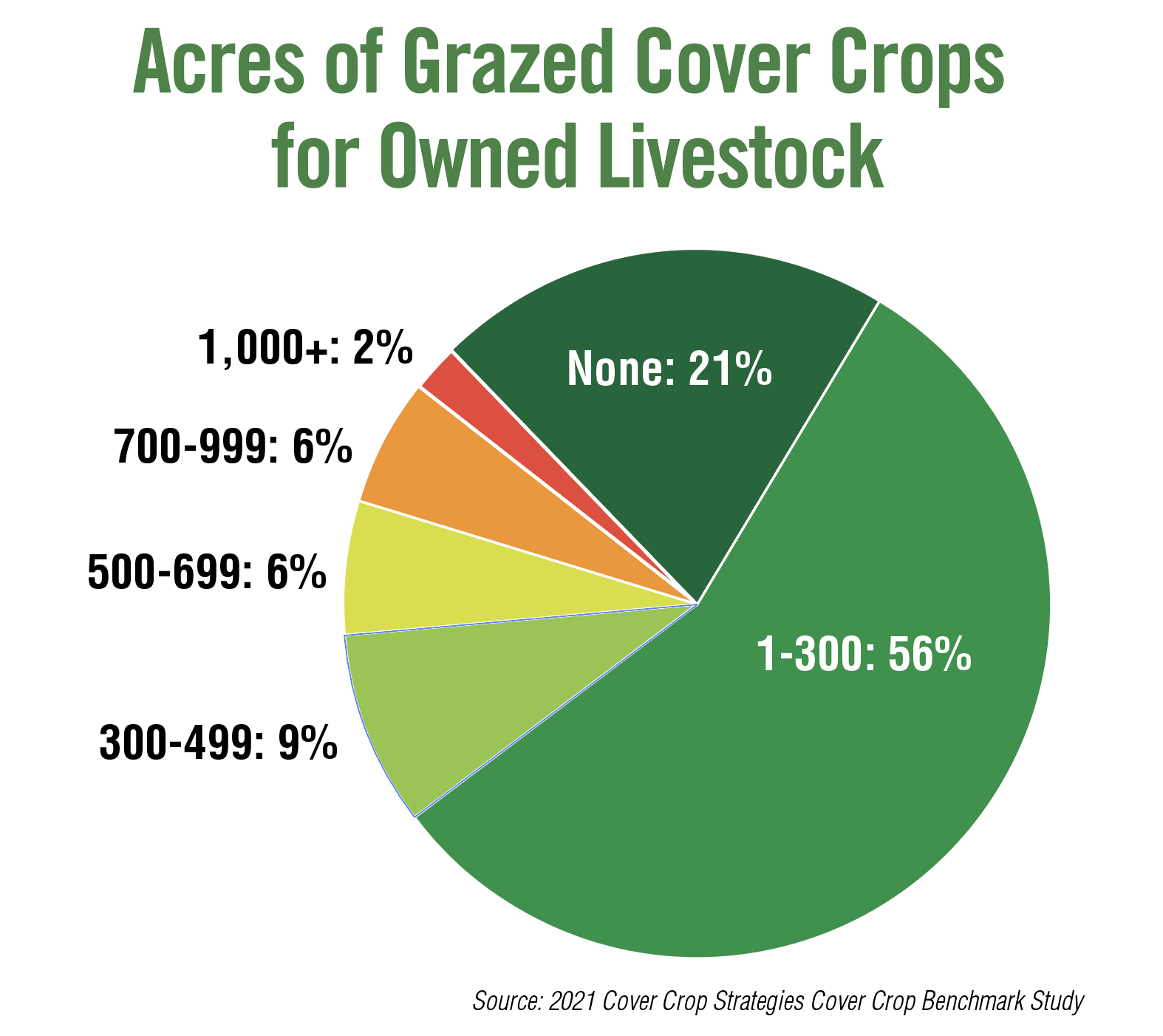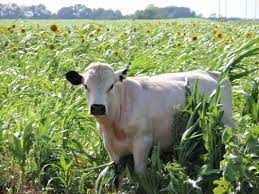Using cover crops as livestock feed can provide additional synergy to growing cover crops while providing additional soil health benefits and an extra income stream.
Feed is the largest expense when it comes to raising livestock, so raising your own cover crops can provide a built-in feed source during winter months when other feed sources may be more costly.
If a grower doesn’t wish to own livestock, that’s fine. There are plenty of livestock producers who would be willing to rent out cover crop acres to graze, making a win-win scenario for both the cover crop grower and livestock producer.
In the 2021 Cover Crop Strategies Cover Crop Benchmark Study, only one-third of survey respondents stated that they grazed cover crops or rented covers for grazing last year. Out of those growers who did graze covers, 57% of them grazed less than 300 acres. These figures did not change much from the 2020 Benchmark Study results.
Those percentages look nearly the same when growers were asked how many acres of cover crops they plan to graze during the current growing season. Fifty-six percent of growers grazing covers expect to graze less than 300 acres and 21% will not graze any cover crops. The number of growers who plan to graze covers is down 8 percentage points from last year, while the number of growers who will not graze at all is up 6 percentage points.

The study found the vast majority of growers don’t rent out cover crop acres for grazing, coming in at 71%. However, this majority owns livestock, so those growers are most likely grazing their own animals on any cover crop acres.
Sixteen percent of survey respondents rent out less than 300 acres of covers. For those 11% of growers who do not own livestock, yet are not renting out their cover crop ground for grazing, they may be missing out on an additional income stream.
This year’s top cover crop species for grazing was cereal rye, coming in at 59%, edging out last year’s winner, radish, by 5 percentage points. Rounding out the top 10 species were turnips (50%); oats (49%); sorghum-sudangrass (33%); crimson clover (29%); annual ryegrass (29%); sunflower (27%); triticale (26%); and red clover (24%). When compared to the top 10 grazed cover crop species from the 2020 Cover Crop Benchmark Study, hairy vetch fell out of the lineup, while triticale surged higher in popularity.
Beef cattle seem to be the most popular choice of livestock for grazing cover crops, with 87% of survey responses stating such. Dairy cattle came in second at 10%, with last year’s second most popular species, sheep, coming in at 6%.
Survey respondents were equally split when it comes to choosing which type of grazing system to utilize. Rotational grazing and open/unrestricted grazing tied at 49%, with open/restricted grazing bumping up 9% over the 2020 Benchmark Study results. It is important to note that an additional 22% of growers use mob/high density grazing, although the practice was down 6 percentage points from 2020.
When it comes to the feeding window for grazing covers, more than half of growers do so for more than 90. A respectable one-third chose 45-90 days, which is up 4% from 2020. Only 17% of growers indicated that they graze covers for less than 45 days.
About 60% of growers don’t bale cover crops for livestock feed, while 40% do bale them for feed. Using cover crops as silage is not very popular, as evidenced by only 17% of respondents doing so.
The most popular season for grazing cover crops was the fall, coming in at 74% — a full 10 percentage points higher than the 2020 Benchmark Study. Winter was the next choice of season for grazing covers with 47%. Thirty-nine percent of growers graze cover crops in the spring, compared with a 33% of growers who graze covers in the summer.
Although grazing livestock on covers provides soil health benefits, there are also benefits to be gained when it comes to animal performance and health.
Seventy-one percent of growers see a rate of gain of ½ a pound per day, compared to 29% of livestock on pasture and/or regular feed. Another 63% noted a 2-2.5-pound rate of gain per day, compared to 37% on pasture and/or regular feed. An additional 59% added 1.5-2 pounds of rate of gain per day for their livestock, compared to 41% on pasture and/or regular feed.
Grazing livestock on cover crops can be a highly economical way to put weight on, according to the survey results. Seventy-five percent of livestock producers paid $80 and/or $100 per pound of gain for their livestock, compared to 25% who paid the same price to get the same pound of gain using pasture and/or regular feed.
Another 67% paid $40 per pound of gain on cover crops, versus 33% who paid the same amount on pasture and/or regular feed. Another 60% of livestock producers paid $70, $90 and/or $110 per pound of gain, compared to 40% of livestock producers who fed cattle out on pasture and/or regular feed for the same cost per pound.
There can be a couple of animal health problems related to grazing, such as bloat, but the vast majority of livestock producers did not encounter these issues when grazing cover crops. Ninety-two percent of livestock producers did not have any health problems related to grazing cover crop mixes.
There are savings to be had by grazing livestock on cover crops. Some 42% of survey respondents made under $50 per acre of their gross income from grazing livestock on cover crops, followed by 22% who made $51-$75 per acre. Thirteen percent of survey participants boasted a profit of $100-$150 per acre income from grazing livestock on covers. Seventy-one percent of growers who rented out their cover crop acres made less than $50 per acre in gross income.






Post a comment
Report Abusive Comment